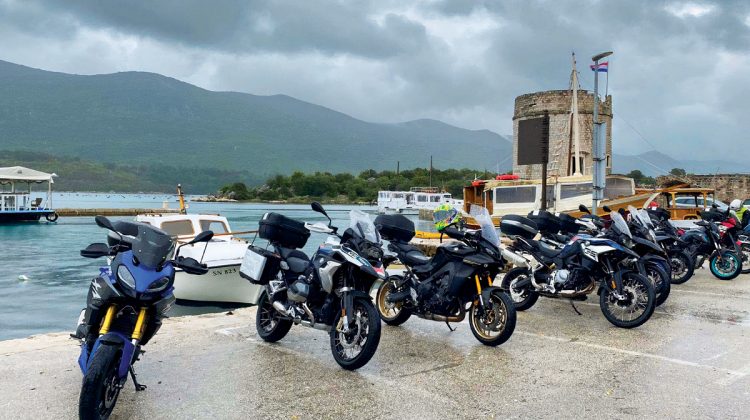
The landscape, what I could see of it through the gloom, was green and verdant, reminiscent of my native southwest Virginia, but higher and wilder. I was south of Plitvice Lakes National Park, following a string of red taillights of my fellow travelers. Even a week before from home, the Weather Channel’s long-range forecast for this Adriatic area looked ominous, so I packed full raingear along with my helmet, boots, gloves and riding suit in the biggest-ass duffel bag I could find. Rain would be a constant theme.
But I digress.
I was riding a guided eight-day, 1,000-mile tour provided by Adriatic Moto Tours, based in Ljubljana, Slovenia, starting there and making a grand loop through Croatia and Bosnia and Herzegovina — the latter two are the same nation. All were remnants of the now fractured, former Yugoslavia along with Macedonia, Montenegro and Serbia. Why did I pick this tour? I always like visiting new places, adding new nations to my life list.
I spent an extra night before the tour in lovely Ljubljana, meeting my roommate for the tour, George Hatjakes from Nevada. Ljubljana is charming, with the requisite old town dating back to the Middle Ages, the obligatory castle on the hill, the gentle river running through, and the small, charming pedestrian bridges. A winged, barb-tailed dragon is the city’s mascot, depicted atop the castle’s tower and on the portals of the Drago Bridge, representing courage, power and greatness.
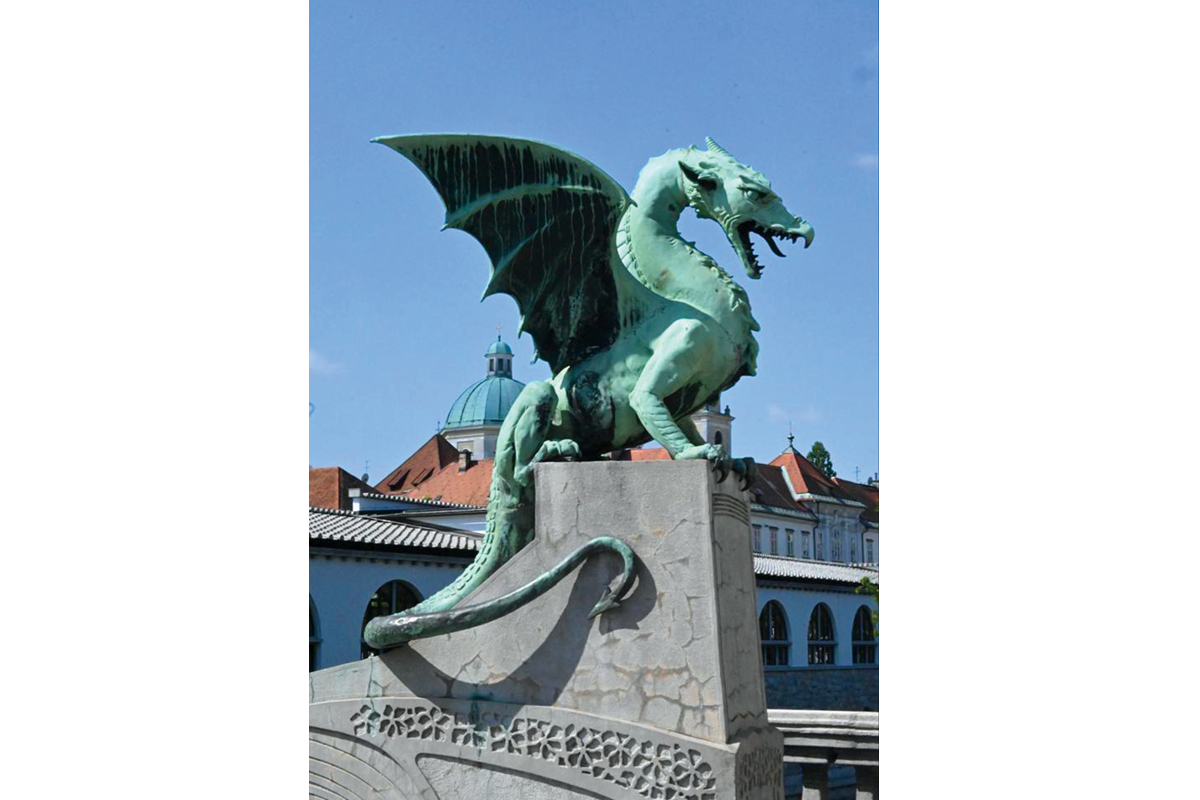
George is a portly never-met-a-stranger guy with a round face and gap-toothed perpetual smile, extroverted and preternaturally generous, and I liked him immediately. We rode the scenic river tour on 20-passenger boat and then explored the castle before finding dinner at a crowded food fair.
We found ourselves in conversation with three female diners, all schoolteachers, who frequented these weekly fairs. Speaking English adroitly, they eagerly welcomed us to their tiny, proud nation of 2.1 million people that produced NBA basketball players Luka Don č i ć and Goran Dragi ć , former two-time Tour de France winner Tadej Poga č ar, and former model and businesswoman Melania “I really don’t care. Do U?” Knauss.
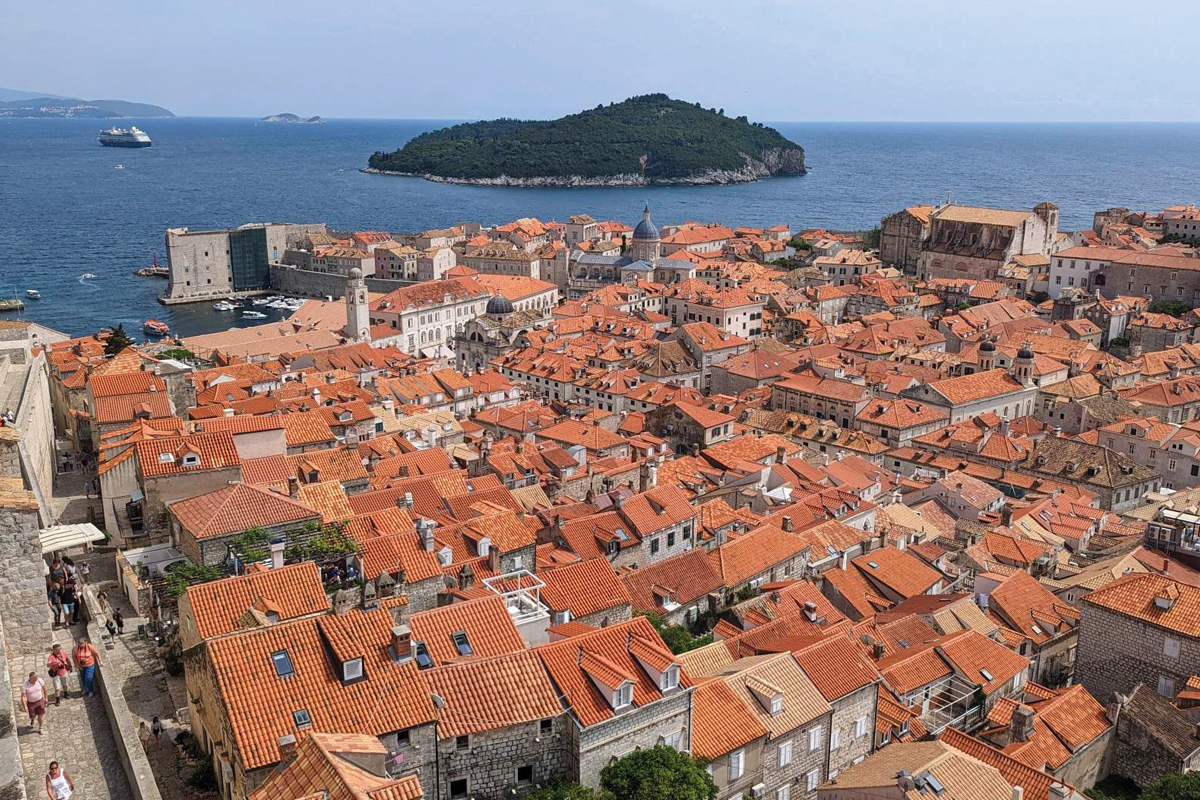
The next afternoon, the tour group gathered for the first time to get acquainted and meet our hosts, tour guide Matej and sag-wagon driver Jure. Our group numbered 13 riders, with one couple, one single woman, and the rest of us single men, representing Australia, India, and Canada in addition to the United States. Matej explained how the tour would operate, with a unique mobile turn-marker system, border crossings, and gas stops. We were responsible for our gas, coffee stops, and lunches, but he collected money from us beforehand and put it into a “kitty” from which these expenses were tracked and debited. My total gas consumption was just under 80 Euros, around $85. Each of the bikes was equipped with a BMW handlebar mounted GPS, all pre-programmed with daily routes.
We took two taxis to a garage on the outskirts of the city where we met our wheeled steeds for the week. Mine was a lowered version of Yamaha’s MT-07, a frisky, sportscar-like naked bike, perfect for my inseam-impaired body. There were several BMW GS models in various displacements from 310cc to 1250cc, a Honda TransAlp, Suzuki V-Strom, and three Yamahas, all equipped with a large Givi rear trunk and all immaculately prepared. We then rode them on a get-acquainted 30-mile tour back to the hotel.
•••
The next morning the tour officially began with a short 130-mile run southward into Croatia where we stayed at a charming, rustic hotel near captivating Plitvice National Park. After checking in, we got shuttled to the park for a 4-mile hike through its canyon which features 16 tufa (limestone) lakes, interconnected by a series of bridal-veil waterfalls, each more scenic than the one before. The waterfalls ripple over natural dams of travertine barriers, covered in lush vegetation growing at a rate of about 1 cm per year. Its river literally builds its own dams!
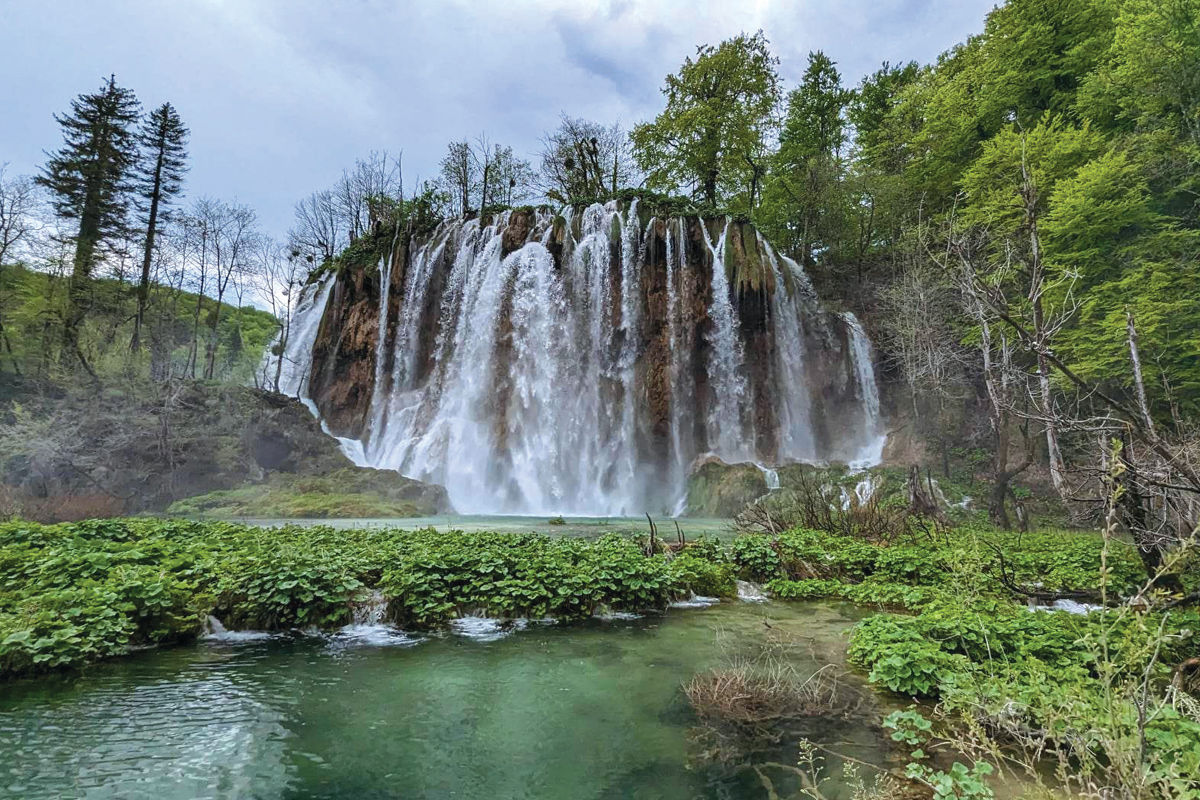
I hiked mostly with Jure, an ebullient, jovial young man who taught me some Slovenian greetings (Živjo! Dober dan!), and I taught him some English words to add to his already impressive second-language fluency.
We took a passenger boat on a 45-minute cruise across the largest lake. Heavy rain bounced on the boat’s metal canopy as we boarded and abruptly stopped a minute after we disembarked. I hoped that would be a positive omen of what was to come.
It wasn’t.
On my weather radar app, we were in the midst of a yellow-red bruise. It rained most of the night, and as I alluded earlier, was still raining when we departed southward on a 212-mile ride to Mostar. The road was uneventful and sparsely used, so I had no problems other than visibility through my fogged shield, but I was still happy when the skies broke an hour later. The landscape was sparse and became more arid, reminding me of the American Southwest, and we made good time.
My travel-weary brain lapsed into automaticity, the state of mindless driver’s amnesia where through the serpentine curves, my Yamaha, the road, and I became one, part of our two-wheeled cavalcade flowing through space and time.
Near Imotski, we stopped to see the twin giant sinkholes of Blue Lake and Red Lake, both more than 700-feet deep from the lakes’ shimmering surfaces to the rims. Matej flew his drone overhead from our scenic overlook to get good photos capturing the astonishing depth.
International agreements dictated that the prior day’s border crossing into Croatia did not require that we stop — we rode right through the checkpoint — but into Bosnia and Herzegovina we had to show our passports and bike registration, a minor inconvenience. While waiting for other riders to show their documents, several of us chatted up a uniformed agent, eager to speak English and tell of his awful memories of the war. He told us his brother disappeared in 1992 and was never seen again.
The ensuing short ride was the most frustrating of the trip, as we descended into Mostar behind a bevy of snail’s pace trucks. Mostar was paradoxically both enchanting and horrifying.
We walked from our hotel into the old town where vendors sold lovely Turkish tea settings, along with standard souvenir fare. We walked over the rebuilt 16th century humpback bridge over the clear, fast-moving Neretva River and had a memorable dinner before a restful sleep.
The town endured the horrors of the Balkan conflict of the 1990s. I’d been to battlefields before, places like Gettysburg and Appomattox that were all serene, reverential places now known only in history books. I’d never been to a war zone fresh in the memory of living people who experienced it first-hand and could describe the anguish. I left there with my soul deeply troubled over the viciousness and futility of war, literally the worst action humankind has ever devised.
•••
The next morning, we took a short ride to the tiny village of Blagaj, where nearby Vrelo Bune is home of a most extraordinary natural feature. Within a steep-walled canyon, a spring, the source of the Buna River flows from the base of an enormous canyon. At only 9 kilometers long, it’s Bosnia’s shortest. I’ve seen springs before, but they’ve all been tiny creeks, whereas this was a strong torrent of more than 1,000 cubic feet-per-second of extremely cold, pristine water.
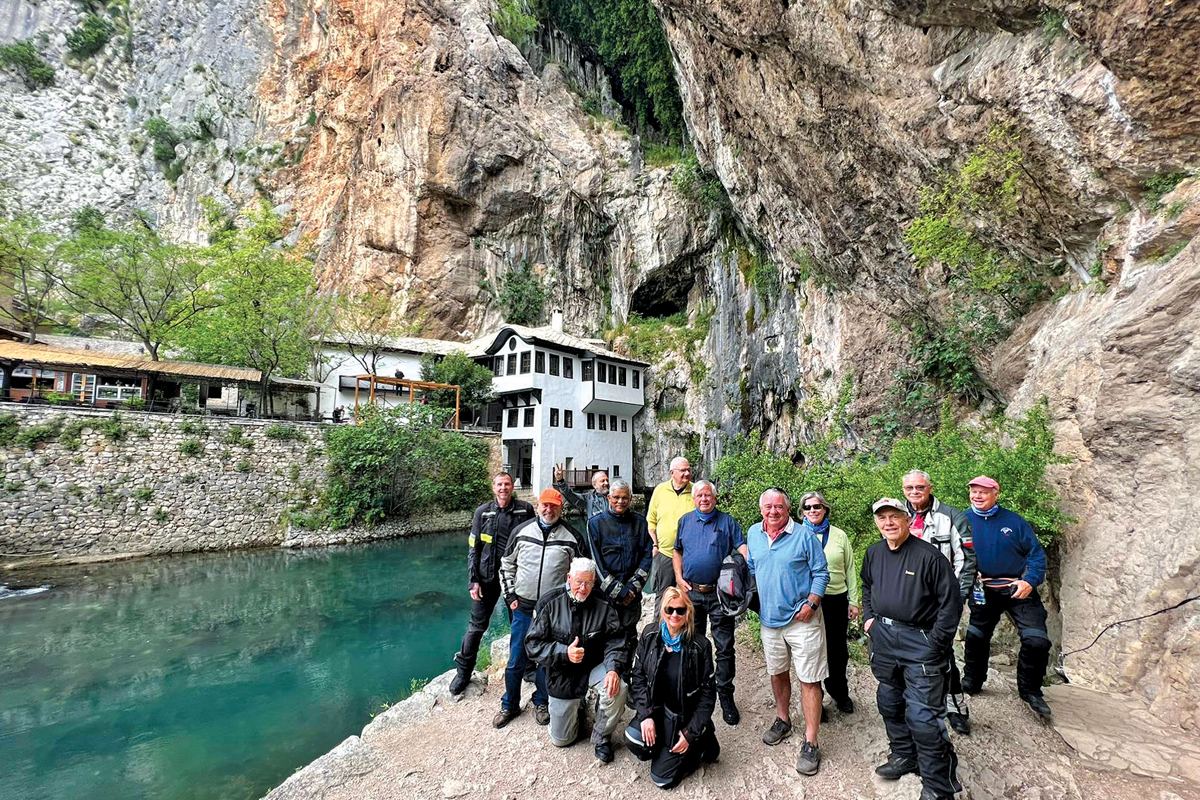
We backtracked to the main highway and then took the long road into Croatia toward our rest-day destination at Dubrovnik. The coastal city began as a small settlement in pre-historic times, with the basic city plan dating from 1292. During the 15th and 16th centuries, Dubrovnik was one of the Mediterranean’s most important and prosperous cities and is now a popular tourist destination. The city was nearly destroyed by an earthquake in 1667 and was extensively shelled during the Balkan war in 1991. It is now fully rebuilt and is a popular filming location, used in the HBO series “Game of Thrones.”
The approach we took into the city descended steeply from the mountains above and the views, our first to the Adriatic Sea itself, were dramatic. From that lofty vantage, the old city sits on a small peninsula and features a mosaic of orange tile rooftops inside an enveloping stone wall.
On our rest day, we toured the city in resplendent sunshine. We had a two-hour guided tour in the morning led by a charming young woman.
“My name is ‘Anada,’” she said, “like ‘Canada’ without the ‘C.’”
George and I continued exploring on our own, circumambulating the old town, walking atop the wall. He hadn’t brought rain gear, so he set out to try to buy something. He’s from Nevada where rain is infrequent, so he didn’t think it would be necessary. A small-suitcase type of traveler, he teased me about my voluminous load, but I ultimately wore everything I brought. He was unable to find rain gear.
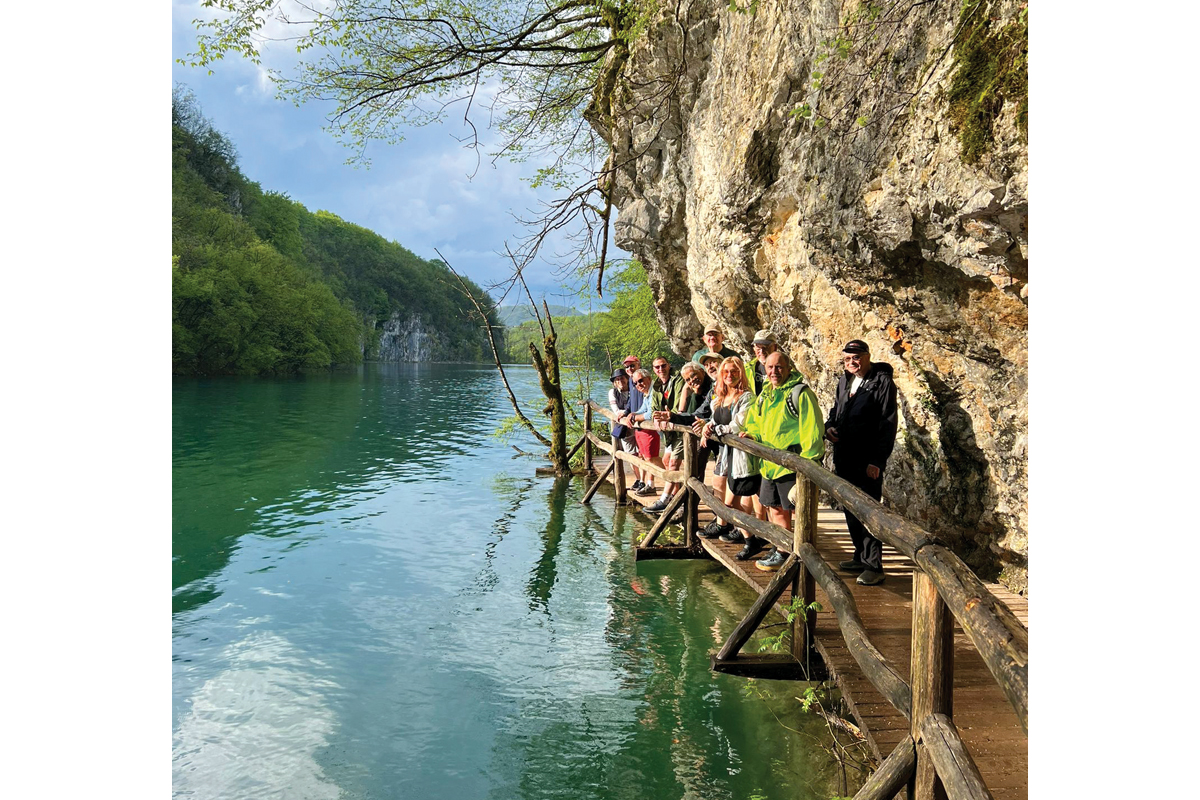
•••
It rained heavily again all night and was still raining by morning. I was tired from all the travel and freaked-out by the poor visibility, so I had Jure put my trusty Yamaha in the sag-wagon and I rode in a passenger van with Chris, an Australian who was accompanying his friend Gunther and two of the other guest riders who also chose to sag it.
We followed the procession of our riders in a drenching, road-splashing torrent northward along the coast to Drvenik to catch the ferry to Hvar Island. By our lunch stop in Su ć uraj, the rain stopped. I was itching to get back on my bike. Instead, with the sag wagon already farther up the road, I stayed in the van to the town of Hvar, the largest settlement on the island, and a major tourist town.
Once there, rather than checking into our hotel, the most ostentatious resort hotel of the entire trip, I hopped on the Yamaha and rode alone on a narrow, macadam country road across a breathtaking 1,000-foot pass to the next day’s ferry landing and back.
The downtown square in Hvar had signs warning tourists about significant fines for wearing inappropriate clothing, meaning skimpy bathing suits. “SAVE YOUR MONEY AND ENJOY HVAR,” signs admonished in uppercase English.
At the harbor, I walked past lines of anchored yachts where I could see rich, well-dressed people lounging and consuming adult beverages. I thought about trying to invite myself aboard one or two of them, but figured it was unwise to test the limits of Croatian hospitality.
That evening, we enjoyed the most memorable meal of the tour. We were taken in taxies to a canyon 10 kilometers away where we approached a small compound or hacienda. We were seated at a long outdoor table under a canopy of low trees and light-bulb strings, and personally greeted by the proprietor.
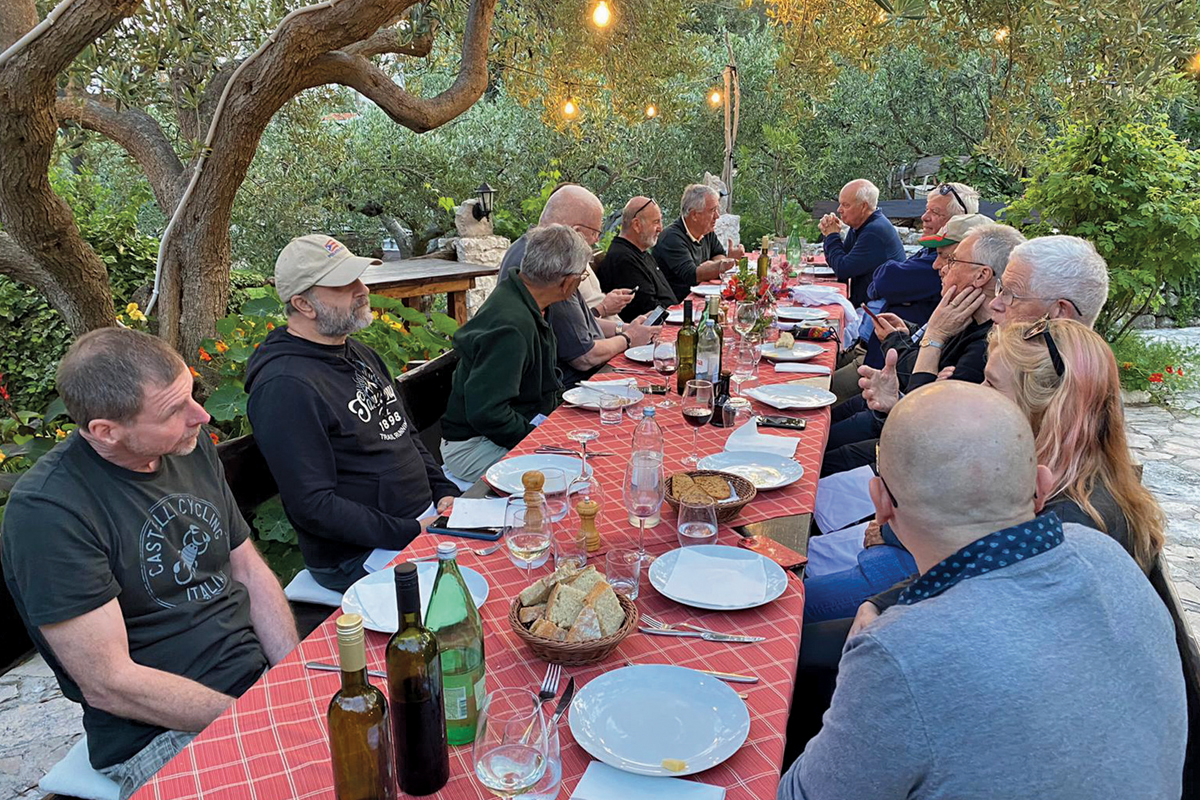
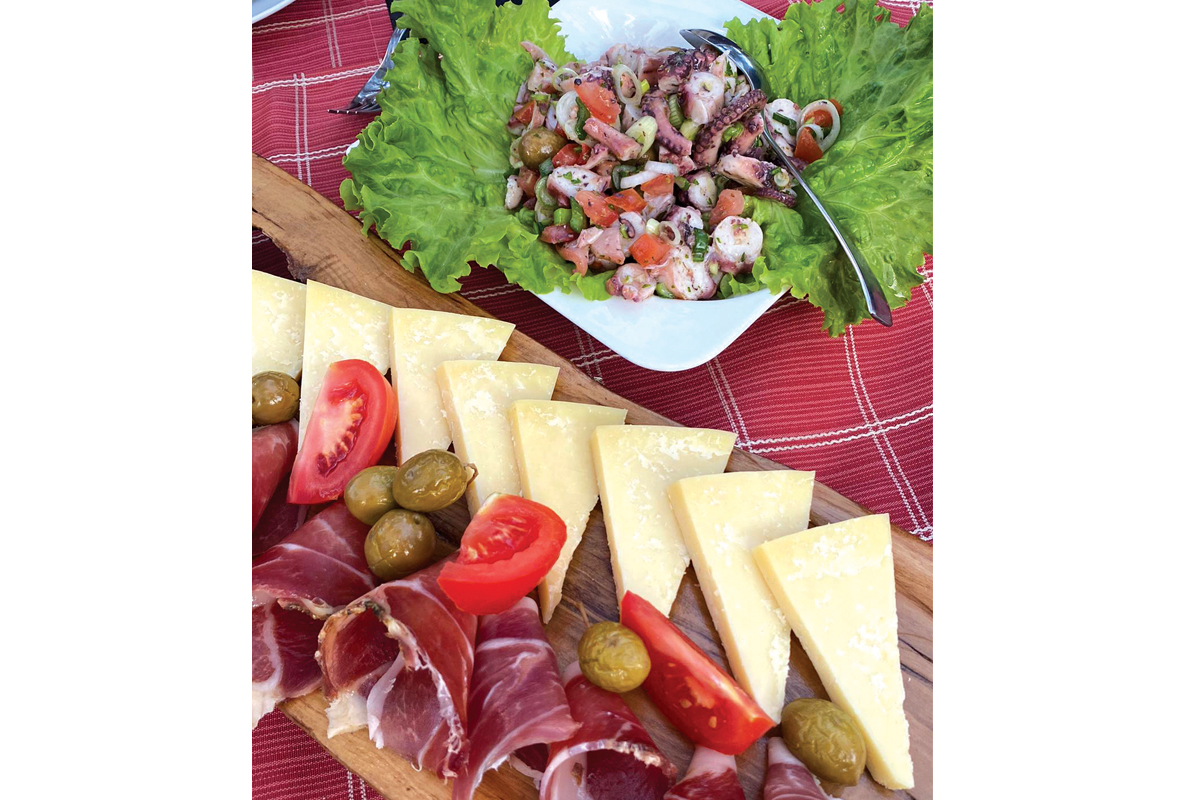
Welcoming us, he presented to each of us a small glass of homemade grappa. Wooden trays of cheeses, olives, prosciutto, and tomato slices appeared, along with plates of octopus salad. Next, platters of deeply piled delectable seafood were brought and placed between us, communal style, along with bottles of water (still and gassy) and homemade wine. Squid, white-fish, shrimp, clams, steamed vegetables, tiramisu for dessert. It was unforgettable, story-book mystical, a moment of gastronomic fantasy, never to be forgotten.
“The food was unbelievably fresh,” said Bill, a rider from Illinois echoing my reaction. “The preparation and presentation were amazing. The family did the cooking and the serving. It felt like being in someone’s home. It showed what meals could be.”
Speaking of food, it was eclectic but uniformly delicious everywhere we went. The most fun was when there was no menu, but the restaurant simply served us the meal of the day. The salads were fresh. The meats were delicious. The pastas were wonderful. The wines were great, and the desserts were luscious. The seafood quotient increased when we were nearer the Adriatic. Each hotel had a massive breakfast buffet with thin-sliced meats, eggs, grains, fruits, breads, yoghurts, and cheeses.
•••
The next morning, our penultimate riding day, we retraced the short ride I’d done the day before to the north side of the island for our longest ferry ride to Split. I had a minor pavement encounter on the way down, dropping the Yamaha on some gravel as I stopped to get a photo. Fortunately, there was no harm to me or the bike.
The ferry was two hours long, during which Matej and Jure served us a picnic lunch which they had dutifully purchased for us and carried aboard.
Adriatic Moto Tours provides rental bikes or self-guided tour options in addition to guided tours like ours. Matej and Jure were amazing — wonderfully helpful, competent, knowledgeable, patient, and well worth the extra money. And it was good craic sharing the day’s events with the other riders.
It was afternoon by the time we reached its terminus at bustling Split. We had a pleasant ride most of the way up the coast to Zadar before all hell broke loose. With storm clouds looming ahead, Matej brought our procession to a stop where he encouraged us to don our raingear again. Shortly thereafter the sky turned as dark as the inside of a cow and the clouds spit fury and anger on us. Riding along in the torrent, I began seeing a carpet of white, granular material on the pavement surface. My travel-addled brain first concluded that perhaps a truck had spilled salt or maybe sand, but then I realized it was hail, literally an inch thick, pushed out of the tire tracks by the cars ahead of us. I rode gingerly, keeping my Yamaha in the tracks, instinctively grasping that whatever it was, black-equals traction and white equals slippery.
Most of our team and I traversed that slimy minefield and the rain had ceased when we stopped a few miles later at a service station, but riders at the tail end of our procession weren’t with us. Matej whipped his huge BMW GS 1250 around and went back to investigate. One of our riders had crashed on the ice. Matej called us to instruct us to find the rest of our way into Zadar without him. Arriving, we learned that Jure had returned with the sag-wagon to haul in the crippled V-Strom, damaged too badly in the crash to be ridden. Fortunately, the rider was unhurt, but his riding was over.
•••
Zadar is another coastal town. Its most memorable feature is a “sea organ,” a unique installation of 35 pipes installed in the concrete vertically to the sea where the rising tides and waves produce varying tones. Enchanting!
Our final ride took our coterie back to Ljubljana, first heading due east from Zadar and then an abrupt 90-degree left turn to the north along the stunning Adriatic coast. Another storm cloud was dead ahead as we went east, but blissfully we skirted it when we turned. The coastal road to Rijeka provided the best riding of the entire tour, the road hugging the rugged coastline, mountains to our right and islands to our left, sweeper after endless sweeper, motorcyclists buzzing all around. After leaving the coast, we had lunch in Delnice and then re-entered Slovenia, riding through bucolic farm country.
And then, perhaps as a fitting punctuation for our tour, the skies opened up yet again. The last hour of riding was on a fast freeway in a drenching, vision-obscuring rain, a sphincter-tightening, nerve-wracking event that couldn’t end soon enough. I stayed dry, mostly, but by the time we reached the Adriatic Moto Tours garage for our celebratory flutes of champagne, my roomie George was soaked and cold.
We had dinner that evening together in Ljubljana before the tour officially disbanded, saying goodbye to our guides and new friends, and exchanging hugs and addresses.
Superb riding. Great food. Stunning scenery. Fascinating culture. Excellent hotels. Wonderful guides. Fun motorcycles. Beautiful roads. The hotels, restaurants, and stores were clean and attractive and the people we met on the way were warm and welcoming.
My only criticism was our tour’s strict adherence to the schedule which had us riding in severe weather that we might have at least partially avoided by waiting out the most intense storms.
Would I do another tour? In a heartbeat. Except maybe next time I’ll go to Greece. I understand it’s dry there.


